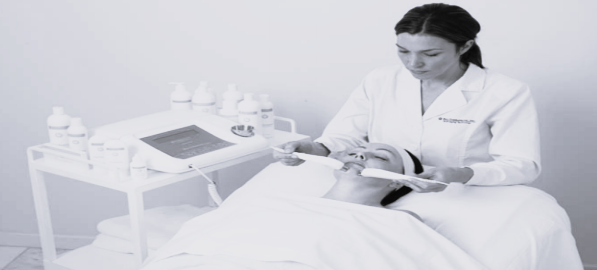The Basic Treatment Techniques of Sun-Damaged Skin

The Basic Treatment Techniques of Sun-Damaged Skin
The Basics of Treating Sun-Damaged Skin
- Sun exposure must be carefully avoided, especially during the hours between 10 a.m. and 3 p.m.
- An SPF 15 (or higher) broad-spectrum sunscreen should be worn on a daily basis, and incorporated into a day cream or fluid.
- An 8 to 10 percent alpha hydroxy acid product, with a pH of no less than 3.5, should be used daily.
- A daily stabilized broad-spectrum antioxidant serum applied to the skin will help prevent cell damage, and in the long term will help prevent skin breakdown resulting in wrinkles and elastosis.
- A serum or cream containing peptides, such as palmitoyl pentapeptide-4 (formerly called palmitoyl pentapeptide-3), or the newer complex of palmitoyl oligopeptide and palmitoyl tetrapeptide-7, should be used daily. Collagen stimulants such as hydrocotyl (Centella asiatica) and coneflower (Echinacea purpurea) may also be used, or combined into this type of product. Serums and creams are now available that contain a blend of liposomed antioxidants, collagen stimulants, and peptides.
- Avoid all irritation and sources of inflammation to the skin.
- Hydration helps improve moisture content in the skin, improving smoothness and elasticity.
- Lipid-based products are especially effective for dry and dehydrated sun-damaged skin. Lipid products help improve hydration and barrier function.
People who are not used to a multi-step program may wish to “phase in” the program.
This approach sometimes is helpful in getting clients accustomed to a home regimen, but you should insist to the client that the whole program must be followed to achieve the results they are expecting.
In other words, be understanding of their need for simplicity, but also make them understand that all the products must be used to see the results they want.
Cleansing should be gentle and thorough, and the client must avoid any harsh cleanser, including bar soaps, which can be stripping and damaging to the barrier function.
Cleansing milk or a light, rinseable liquid cleanser is advised.
This should be followed by a mild non-alcoholic toner, which helps to remove cleanser residue and lower the pH of the skin.
After cleansing and toning, the client should apply an antioxidant serum.
Sometimes these will also contain peptides.
It is important to follow manufacturers’ instructions because products do vary in ingredients and product form, such as a serum versus a lotion.
The client should then apply the alpha hydroxy product, which could be a serum, gel, lotion, or cream, depending on the skin type.
During the day, this product will be followed by an SPF 15 or higher broad-spectrum sunscreen with a built-in hydrator.
For drier skin, make sure the sunscreen contains lipids to help support the barrier function and protect against daytime moisture loss.
In the evening, the same basic steps are followed, but this may vary depending on the client’s specific needs or differences in product type.
Supplemental products, such as eye creams, or specialty serums, such as a concentrated lipid serum, also may be advisable depending on the skin type.
Eye creams, normally used both day and night, can contain peptides, lipids, antioxidants, bioflavonoids, or even low concentrations of alpha hydroxy acid.
The choices depend on the skin type.
Concentrated lipid serums are helpful for very dry, wrinkled skin or areas of extreme damage like the neck or wrinkles around the mouth or eyes.
Lipid serum is applied after all other products, including sunscreen, but before makeup application.
Salon Treatment Program
The first treatment performed for aging skin should include a thorough analysis of the skin conditions and a complete consultation with the client.
At this appointment, you should plan the client’s skin care program for professional treatments as well as home care.
Many programs begin by treating the skin with regular clinical facial treatments, emphasizing moisturization and light stimulation through massage techniques.
Design the treatment for the skin type (oily, dry, etc.) and, if necessary, perform deep cleansing with extraction for any sun-damaged skin that is also oily or comedonal.
A good first step in skin improvement for sun-damaged and aging skin can often be accomplished by performing a series of six professional alpha hydroxy acid treatments.
AHA exfoliations are extremely helpful in treating the sun-damaged skin.
After the client has been using 8 to 10 percent AHA home-care treatment for at least two weeks, administer 30 percent AHA applications in the salon, twice a week for three weeks; follow with weekly treatments if necessary.
Discontinue or temporarily delay any treatment that is irritating or produces lasting redness.
Over the long term, regular monthly or twice-monthly AHA exfoliation treatments are advisable, alternating with hydrating facial treatments.
Performing a series of AHA treatments near the beginning of the treatment program for aging skin helps remove unnecessary surface dead-cell buildup and will show quick improvement in the skin texture and leave the skin in better shape for other treatments both in the salon and at home.
Microcurrent Treatments
The high-tech microcurrent treatments use extremely small amounts (less than 400 microamperes) of galvanic current to improve both skin texture and elasticity.
Traditional galvanic treatments are up to 20 times the microamperage and do not have the same effects on the skin as the lower levels of current used in microcurrent treatments.
Microcurrent treatments are ideal for a client who is beginning to think about a facelift but is not quite ready for surgery.
Although it is not the same as a facelift, microcurrent, applied correctly with specific patented technology, has been shown in university studies to improve elasticity, collagen content, elastin content, and blood circulation.
Microcurrent stimulates the skin cells, significantly increasing adenosine triphosphate (ATP) by as much as 500 percent in the cells.
Microcurrent has also been documented to decrease inflammation and swelling.
Sometimes referred to as “muscle re-education,” microcurrent can help tighten or relax muscle tissue, depending on the area.
The current used in microcurrent is so gentle that it does not cause visible muscle contraction.
However, when administered in the salon correctly in a treatment series, usually two to three times a week for 12 treatments, microcurrent can produce great improvement in elasticity and contour.
Microcurrent treatments must be routinely administered after the initial series to keep up the results.
If the person quits coming for treatments, results will not be maintained.
This should be explained to the client before ever beginning the series.
It is a great idea to have “before and after” pictures of clients’ results to show to other clients considering the treatment.
This is true for all types of aging skin treatment programs, including AHAs, peptides, and home-care programs.
You must, however, obtain written permission from the clients whose photographs you are presenting.
There are a few contraindications for microcurrent treatment.
These are similar to those for galvanic current.
Patients with heart problems or a pacemaker, persons who have seizure disorders, pregnant women, and any client whom you feel might have questionable health conditions should not have treatment until she or he obtains written permission from their physician.
Well-made microcurrent machines can be expensive.
As with all equipment and product lines, it is important to check out the qualifications of the company and their training programs.
Light-Emitting Diode Treatments
We briefly mentioned the use of light-emitting diode (LED) treatment earlier in this book when discussing treatments for redness.
LED treatment devices are fast, flashing lights that emit energy to the skin, modulating cellular activity.
Hence, LED procedures are sometimes referred to as photo modulation.
LED treatment has been shown to improve redness and stimulate fibroblasts to increase collagen content in the skin, resulting in improved smoothness, texture, tone, and reduced appearance of fine lines.
The treatments can be helpful in improving skin texture and diffusing redness in mild to moderately sun-damaged skin.
LED treatments are administered in a series of weekly or biweekly sessions and must be followed up to maintain results.
Contraindications for LED include epilepsy and seizure disorders.
Other precautions should be taken, such as having the client wear eye goggles.
Again, carefully shop when purchasing an LED machine.
There are differences among machines.
Always work with a reputable manufacturer who can answer your many questions and who has documentation of results and safety.
Which Treatment Is Right for Me?
None of the treatment methods mentioned in this chapter are substitutes for one another.
You should plan your client’s treatment based on your skin analysis and the client’s desires.
Many clients use all the methods mentioned.
They are all different in which signs of aging they improve and treat.
Some aestheticians tend to “drop” good treatment techniques, products, or ingredients because of trends.
A new technique comes along, and they forget all the advantages of the classic treatment in favour of a new, trendy technique.
This is not a good scientific protocol.
It is important to recognize the benefits or pitfalls of any treatment method and adapt the client’s individual program to treat his or her specific needs.
The one rule of caution is not to over-exfoliate the skin.
Doing so can cause barrier function damage leading to inflammation, and the trauma can also cause post-inflammatory hyperpigmentation.
Never combine exfoliation procedures in an attempt to speed up the treatment results.
More is not necessarily better
Hyperpigmentation Treatment
Hyperpigmentation is one of the main symptoms of photoaging.
It is also one of the main concerns of sun-damaged clients and one of the most difficult disorders to manage.
We have already discussed in other chapters how hyper-pigmentation occurs during sun exposure.
Long-term sun exposure, as well as hormonal activity, particularly in female clients, results in overproductive melanocytes in the skin.
The melanocytes, the cells that produce melanin, are in the lower epidermis and upper dermis.
They produce melanin when they are stimulated by sun exposure, but the melanocytes also can be stimulated by hormones, exposure to some chemicals (including overstimulating skin care products), injuries to the skin (including laser surgery or some forms of chemical peeling), and many forms of inflammation.
In some clients, melanocytes may actually be present in lower areas of the dermis. These clients rarely are responsive to treatment.
When stimulated, the melanocytes produce melanin as a protective mechanism.
Melanocytes have dendrites, which are small branches on the cells containing the melanin.
The dendrites are “embraced” by the skin cells, which absorb the melanin before they drift toward the surface of the skin.
This process gives the cell a characteristic melanin colour, which is seen as hyperpigmentation when concentrated areas of cells contain melanin.
Three types of products and therapies are effective in reducing skin pigment:
- chemical exfoliation,
- melanin-suppressing agents,
- and sunscreens.
Normally, all three are used in treating hyperpigmented photo-damaged skin.
-
Chemical exfoliation,
Chemical exfoliants include alpha hydroxy acid (usually glycolic or a blend), beta hydroxy acid (salicylic acid), or tretinoin (Retin-A or Renova).
Use of both is not advised, because this may produce unnecessary irritation.
Chemical exfoliants remove cells containing melanin, thus helping to fade the skin.
They also clear hyper-keratinized areas of cell buildup on the skin surface to enable better treatment of the skin.
-
Melanin-suppressing agents
Melanin-suppressing agents interfere with the chemical process of melatonin production.
Many inhibit tyrosinase, an enzyme used to convert the amino acid tyrosine, which is instrumental in the production of melanin.
The only FDA-approved skin-lightening agent at the time of this writing is hydroquinone, available in over-the-counter products at 2 percent and 4 percent prescription strengths.
Other unapproved so-called brightening ingredients, which are all basically melanin suppressants, include kojic acid, arbutin, asafetida extract, bearberry extract, magnesium ascorbyl phosphate (also an antioxidant), and azelaic acid.
Melanin suppressants, particularly hydroquinone, have two drawbacks.
Many clients are allergic to hydroquinone, and it is a strong oxidant, which means it neutralizes and turns darker fairly quickly upon exposure to air (oxygen).
It is best to patch-test clients for hydroquinone use before dispensing the product.
It is also advisable to explain that hydroquinone solutions are fairly easily ruined and should be kept in a cool, dark place; also, they should always be securely closed after each use.
-
Sunscreens
Daily use of broad-spectrum sunscreens (as all sunscreens really should be) and avoidance of sun exposure are imperative if the client with hyperpigmentation wants to see results.
Unfortunately, many of these clients are “sun addicted,” and it is hard for them to give up tanning.
Nevertheless, the aesthetician should insist that for any pigment-evening treatment to work, the sun must be avoided.
It is important to understand that hyperactive melanocytes do not react only to ultraviolet rays.
They also react to heat from the infrared rays of the sun, and to inflammation.
No sunscreen available now, or in the foreseeable future, can block infrared heat.
So, the bottom line is that sun and heat must be avoided for these clients.
The aesthetician is advised to have a thorough consultation with each client to explain all the facts about hyperpigmentation treatment and to provide an informational handout.








